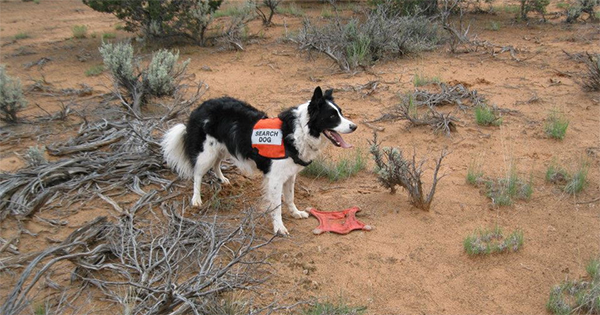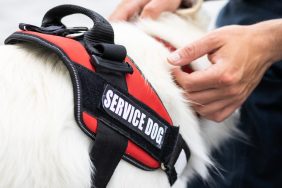Give a dog a job, and you can save a life. That is what Best Friends Animal Society is doing to help dogs at several animal shelters and rescues.
Best Friends’ Canines with Careers program, run by animal behavior expert Sherry Woodard, teaches dog trainers and rescue groups — as well sheriff’s department personnel, prison staff, people who work with at-risk youth, and health care professionals — how to identify, screen, select, train, and place appropriate shelter and rescue dogs for career work.
Woodard told DogTime in 2013 that more than 380 rescued canines were placed in jobs that saved their lives and benefited people. “There are millions of reasons for this program,” Woodard says. “Every day thousands of dogs are dying in shelters across the country, simply because they are homeless. At the same time, millions of people with psychiatric or physical disabilities don’t have the service dog they need. The Institute of Medicine estimates of the more than 40 million people with disabilities, only about one percent of those who could benefit from a service dog actually have one.”
A number of these dogs went to work with search and rescue teams, veterans with post-traumatic stress disorder, and children diagnosed with disabilities. According to Woodward, somewhere between 400,000 and 600,000 military veterans suffering PTSD could benefit from having a service dog. And every year, about 25,000 U.S. children are diagnosed with autism and must endure a long wait for a trained dog to help them communicate and keep them safe.
It’s been a misconceptions that career dogs must be “purpose-bred,” utilizing purebred puppies placed in training between 18 and 24 months of age. Drawbacks include a high cost (between $10,000 and $40,000 per dog), a 50 percent failure rate of dogs who aren’t suited to be career dogs, and long waiting lists.
One of the Canines for Careers programs works with Puppies for Parole, a highly successful program in the state of Missouri, through which selected offenders have the opportunity to become trainers for dogs from local shelters. Dogs that are in danger of being killed are often participants in these programs. The program has spread to almost every prison in the state, making Missouri the national leader in this type of program.
Sandra Jones, who needed a dog to help her with balance issues, submitted an application to Best Friends to receive one of these trained service dogs.
“Sandra’s description of what she needed in a service dog points out that it is the dog’s individual traits rather than breed that determines its suitability for the job,” Woodard says. “Among the traits she needed in her dog were: ‘rock-solid nerves, obeying even in the midst of chaos, intelligence, abundance of good common sense, and a strong desire to please.’”
Ted Martello also benefited from Canines with Careers program. Martello is a disabled veteran who was wounded during a tour of duty in Iraq. He suffers from post-traumatic stress syndrome and traumatic brain injury.
“I called Sherry and told her what my situation was,” he says. “I would not go out in public except for work and it was too overwhelming being around crowds. She sent me photos and descriptions of three dogs and I knew Buster was the right one.”
Buster is a Chow mix who lived at Best Friends Animal Sanctuary, where Woodard had identified his potential and started working with him. Martello drove to Best Friends’ sanctuary in Kanab, Utah, where Woodard introduced him to his new service dog.
Thanks to Buster, Martello is able to handle his emotions. “If I get upset, he calms me down by nudging my hand, which distracts me enough to stop the bad feelings,” he explains. “And because I have to walk him, it helps me to interact with people. Everybody in town knows Buster. If I’m having nightmares he wakes me up. To put it bluntly, if I didn’t have Buster, I wouldn’t be here.”
Woodard’s vision for the future includes Best Friends and other organizations with similar programs changing the career dog field by providing a compassionate, less time-consuming, and more cost-effective alternative to the traditional model.
Sources: Best Friends Animal Society, Canines with Careers, Puppies for Parole









